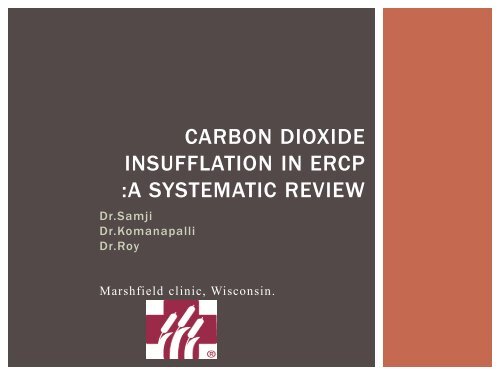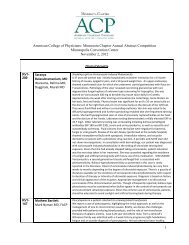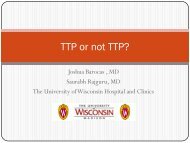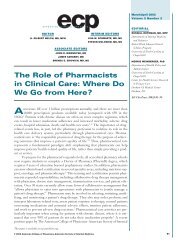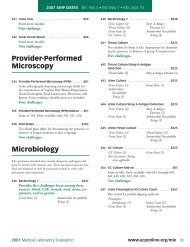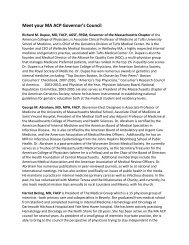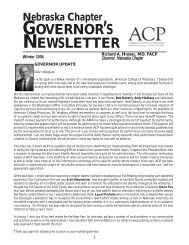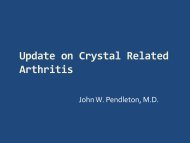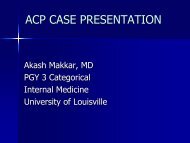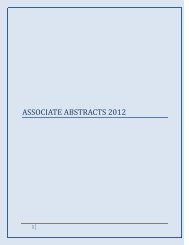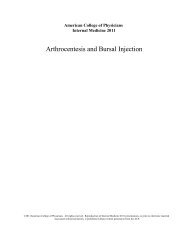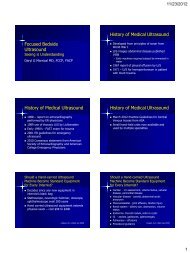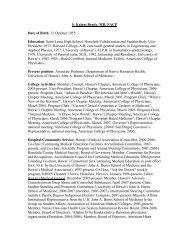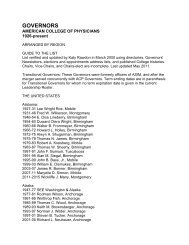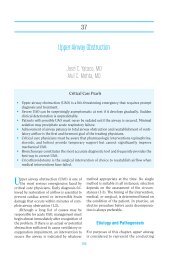Carbon dioxide insufflation in ERCP.
Carbon dioxide insufflation in ERCP.
Carbon dioxide insufflation in ERCP.
You also want an ePaper? Increase the reach of your titles
YUMPU automatically turns print PDFs into web optimized ePapers that Google loves.
CARBON DIOXIDE<br />
INSUFFLATION IN <strong>ERCP</strong><br />
:A SYSTEMATIC REVIEW<br />
Dr.Samji<br />
Dr.Komanapalli<br />
Dr.Roy<br />
Marshfield cl<strong>in</strong>ic, Wiscons<strong>in</strong>.
INTRODUCTION<br />
• <strong>ERCP</strong> is a valuable technique used as a<br />
diagnostic and therapeutic option for many<br />
pancreatic and biliary pathologies.<br />
• Air <strong><strong>in</strong>sufflation</strong> is used for <strong><strong>in</strong>sufflation</strong> of<br />
duodenum.<br />
• Abdom<strong>in</strong>al pa<strong>in</strong> and nausea are the non<br />
specific compla<strong>in</strong>ts of <strong>ERCP</strong>
• <strong>Carbon</strong> <strong>dioxide</strong> is easily absorbed and<br />
excreted compared to air.<br />
• So carbon <strong>dioxide</strong> was thought to decrease<br />
abdom<strong>in</strong>al distension there by decrease<br />
abdom<strong>in</strong>al pa<strong>in</strong>.
AIMS OF THE STUDY<br />
• To compare the effect of carbon <strong>dioxide</strong> to<br />
air <strong><strong>in</strong>sufflation</strong> <strong>in</strong> <strong>ERCP</strong>.<br />
• To assess the safety of carbon <strong>dioxide</strong><br />
<strong><strong>in</strong>sufflation</strong> <strong>in</strong> <strong>ERCP</strong>.
OUTCOMES<br />
• Post procedural abdom<strong>in</strong>al pa<strong>in</strong><br />
• Post procedural abdom<strong>in</strong>al distension<br />
• Dose of sedation<br />
• Safety of carbon <strong>dioxide</strong> <strong><strong>in</strong>sufflation</strong>.
SEARCH STRATEGY<br />
• PubMed, Medl<strong>in</strong>e, Cochrane database and recent<br />
abstracts from major conference proceed<strong>in</strong>gs were<br />
searched.<br />
• RCT’s compar<strong>in</strong>g role of CO2 and air <strong><strong>in</strong>sufflation</strong> <strong>in</strong><br />
<strong>ERCP</strong> were <strong>in</strong>cluded.<br />
• Standard forms were used to extract data by two<br />
<strong>in</strong>dependent reviewers.<br />
• We <strong>in</strong>cluded all the studies that compared CO2 to Air<br />
<strong><strong>in</strong>sufflation</strong> <strong>in</strong> <strong>ERCP</strong> through 7/2012.
2625 Publications<br />
2620 excluded<br />
5 RCT <strong>in</strong>cluded<br />
3 abstracts<br />
<strong>in</strong>cluded<br />
2 RCT 1 Retrospective
GENERAL DESCRIPTION OF STUDIES<br />
• 8 studies were <strong>in</strong>cluded <strong>in</strong> our systematic review.7<br />
studies are randomized double bl<strong>in</strong>ded control trials and<br />
1 study is retrospective study.<br />
• Total number of 925 patients are <strong>in</strong>cluded <strong>in</strong> 8 studies.<br />
• No significant difference <strong>in</strong> patient population noted.
INCLUSION CRITERIA<br />
• Adult pts. requir<strong>in</strong>g <strong>ERCP</strong>.
EXCLUSION CRITERIA<br />
• No consent<br />
• Age < 20 years<br />
• Significant pre procedural abdom<strong>in</strong>al pa<strong>in</strong><br />
• Patients with COPD.<br />
• Pregnant patients<br />
• Chronic use of narcotics-long act<strong>in</strong>g opioid daily more<br />
than 45 days.<br />
• Acute pancreatitis<br />
• Poor health status.<br />
• One study <strong>in</strong>cluded patients with COPD without CO2 retention<br />
or requir<strong>in</strong>g oxygen, CAD,OSA.(Dellon etal)
GENERAL CHARECTERISTICS<br />
NAME OF STUDY Number of patients AGE Sex(female) CO2 DELIVERY PROCEDURE TIME<br />
CO 2 AIR CO 2 AIR CO 2 AIR CO 2 AIR<br />
Brettheur etal 58 58 57+16 54+18 72% 62% OLYMPUS ECR 43+27 48+25<br />
Dellon etal 36 38 60.1+15 59.7+16.6 47% 50% OLYMPUS ECR 39.3 35.1<br />
Lugiano etal 37 39 66.1+14.6 67.1+16.4 59% 53% E Z EM <strong>in</strong>c 34.1+17.8 37.3+17.6<br />
Maple etal 50 50 57 51.7 52% 50% E Z EM INC 31.1 31.6<br />
kutawani etal 40 40 66.1+9.8 68.7+10.9 37% 40% OLYMPUS ECR 45+24.75 43+22.4<br />
Arjunan etal 147 151<br />
sweel<strong>in</strong>chen etal 34 27 58.4 58.4<br />
Bhalme etal 60 60 29 33
EFFECT ON POST PROCEDURAL<br />
ABDOMINAL PAIN<br />
• Abdom<strong>in</strong>al pa<strong>in</strong> was measured by different scales<br />
and at different po<strong>in</strong>t of times.<br />
• No significant difference <strong>in</strong> pre procedural<br />
abdom<strong>in</strong>al pa<strong>in</strong> .
Kutawani Brettheur Lugiano Sweel<strong>in</strong>chen Dellon Arjunan<br />
Maple<br />
Bhalme<br />
CO 2 AIR CO 2 AIR CO2 AIR CO 2 AIR CO 2 AIR CO 2 AIR CO 2 AIR CO 2 AIR<br />
Pa<strong>in</strong> scale<br />
VAS 10 po<strong>in</strong>t VAS 100 mm VAS 100mm VAS 10 po<strong>in</strong>t VAS 100mm VAS 1-10cm VAS 10 po<strong>in</strong>t<br />
VAS 10 po<strong>in</strong>t<br />
pre procedure<br />
Not significant<br />
15 15 5.7+5.4 6.2+6.7 0.38 1.51 12.8+19.6 10.5+21.0 Not significant 0.5 0.48<br />
1 hour<br />
5 19 10+4.4 35+12 0.38 0.37 16.4+25.2 10.8+19.3 0.61+0.67 0.84+0.95 0.7 1.9 0% 10%<br />
3 hours<br />
6 hours<br />
1.4+2 0.9+2 7 21 8+2.5 28.1+9.6 20.8+32.2 22.3+27.8 28% 48%<br />
10 22 7+2.5 14.1+4.7 18.3+25.4 19.5+26.7 28% 48%<br />
24 hours<br />
1.1+1.9 0.5+1.3 4 20 4.2+3.4 5+2.8 15.0+24.7 15.5+24.0<br />
Not significant
• Post procedural abdom<strong>in</strong>al pa<strong>in</strong> was less <strong>in</strong><br />
carbon <strong>dioxide</strong> group till 6 hours after<br />
procedure.<br />
• There was no significant difference between 2<br />
groups 24 hours after procedure.
EFFECT ON POST PROCEDURAL ABDOMINAL<br />
DISTENSION<br />
Kutawani Breetheur Lugiano Dellon Arjunan Maple<br />
SCALE GVS-Xray Xray VAS100mm abd girth-cm Abd girth cm Abd girth-cm<br />
CO 2 AIR CO 2 AIR CO 2 AIR CO 2 AIR CO 2 AIR CO 2 AIR<br />
Pre procedure<br />
0.11+0.04 0.10+0.05 4.2+3.4 4.5+3.7 101.5+15 105.5+16<br />
Post procedure<br />
Rate of <strong>in</strong>crease<br />
0.14+0.06 0.31+0.11 13% 29% 8.8+5.3 31.7+19.2 102.2+14 106.2+17.4<br />
3.8+5.9 21.0+11.1 0.7+3.8 0.8+4.8 0.69+1.12 1.02+1.32 0.3 2.1
• 4 out of 6 studies noticed significant decrease<br />
<strong>in</strong> abdom<strong>in</strong>al distension <strong>in</strong> CO2 group compared<br />
to air group.<br />
• 1 study noticed that 29% patients <strong>in</strong> air group<br />
had moderate to severe distension compared to<br />
13% <strong>in</strong> CO2 group.
EFFECT ON DOSE OF SEDATION<br />
Kutawani Breetheur Dellon Bhalme Lugiano Sweel<strong>in</strong> Maple<br />
CO 2 AIR CO 2 AIR CO 2 AIR CO 2 AIR<br />
Type of sedation fentanyl,midazolam Midazolam,pethid<strong>in</strong>eFentanyl,midazolam Fentanyl,midazolam Propofol Propofol Propofol<br />
Fentanyl (mcg) 115+48.9 130+53.5 155.6 162.2 75 75<br />
Pethid<strong>in</strong>e (mg) 54.4+24.5 38.5+11.1 35.2+27.9 44.0+37.3<br />
Midazolam(mg) 7.3+3.6 8.4+3.7 6.3+3.6 6.4+2.8 9.1 10.7 4 4.5<br />
Diazepam (mg) 2+0.8 2+0<br />
Scopolam<strong>in</strong>e <strong>in</strong>e(mg) 23+6.6 20.6+2.4<br />
Promethaz<strong>in</strong>e z<strong>in</strong>e(mg) 17 25<br />
Glucagon (mg) 1.2+0.4 1.1+0.2 0.5 0.3
• No significant difference <strong>in</strong> dose of sedation<br />
used between 2 groups<br />
• No significant difference <strong>in</strong> dose of<br />
antispastic drugs used.
SAFETY OF CARBON DIOXIDE<br />
INSUFFLATION<br />
Kutawani Brettheur Lugiano Dellon Arjunan Maple Bhalme<br />
Co2 monitor<strong>in</strong>g SPO 2 SPCO 2 PETCO 2 SPCO 2 PETCO 2 SPO2 SPO2<br />
CO 2 AIR CO 2 AIR CO 2 AIR CO 2 AIR CO 2 AIR<br />
Basel<strong>in</strong>e 97.8+1.3 97.7+1.3 NS NS 29.8+1.8 30+1.6 40.5 40.3<br />
Post procedure<br />
97.1+1.4 96.6+1.3 NS NS 32.6+2.6 30.7+1.3 46.1 45.2 NS NS<br />
Maximum CO 2<br />
32.6+2.6 30.7+1.3 50 48.7
• No significant respiratory depression or<br />
respiratory complications noted with CO2<br />
<strong><strong>in</strong>sufflation</strong>.<br />
• No significant adverse events or complications<br />
noted <strong>in</strong> CO2 group compared to air group.
CONCLUSIONS<br />
• <strong>Carbon</strong> <strong>dioxide</strong> <strong><strong>in</strong>sufflation</strong> <strong>in</strong> <strong>ERCP</strong> can reduce post<br />
procedural abdom<strong>in</strong>al pa<strong>in</strong> and the effect lasts till 6<br />
hours after procedure.<br />
• Abdom<strong>in</strong>al distension was less <strong>in</strong> carbon <strong>dioxide</strong> group<br />
compared to air group.<br />
• There was no significant difference <strong>in</strong> dose of sedation<br />
and dose of antispastic drugs used.
• <strong>Carbon</strong> <strong>dioxide</strong> <strong><strong>in</strong>sufflation</strong> is found to be safe <strong>in</strong><br />
<strong>ERCP</strong><br />
• Safety still needs to be established <strong>in</strong> patients<br />
with COPD, obstructive sleep apnea, morbid<br />
obesity, patients who has multiple co morbid<br />
conditions and medically unstable patients.


